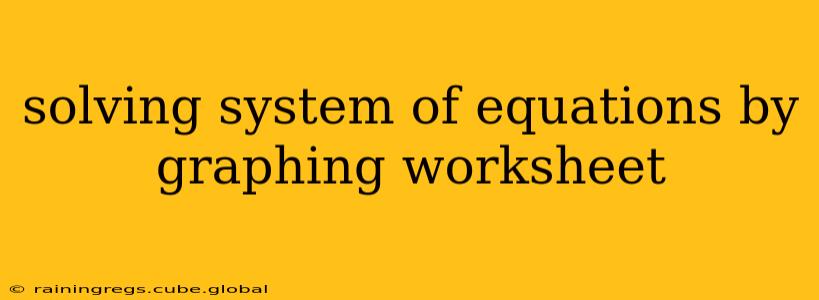Solving systems of equations is a fundamental concept in algebra, and graphing provides a visual and intuitive method to find solutions. This guide will walk you through the process, offering tips and tricks to master solving systems of equations by graphing, making those worksheets a breeze.
What is a System of Equations?
A system of equations is a set of two or more equations with the same variables. The solution to the system is the point (or points) where the graphs of all the equations intersect. This intersection point represents the values of the variables that satisfy all equations simultaneously.
How to Solve Systems of Equations by Graphing
The process involves three main steps:
-
Graph Each Equation: First, you need to graph each equation in the system. The easiest way to do this is to find the x and y-intercepts, or to rearrange the equation into slope-intercept form (y = mx + b), where 'm' is the slope and 'b' is the y-intercept. Remember to use graph paper or a graphing tool for accuracy.
-
Identify the Intersection Point: Once both (or more) equations are graphed, look for the point where the lines intersect. This intersection point is the solution to the system. The x-coordinate represents the solution for 'x', and the y-coordinate represents the solution for 'y'.
-
Check Your Solution: It’s crucial to check your solution by substituting the x and y values back into the original equations. If the equations hold true for both values, you've found the correct solution.
Common Types of Solutions
When solving systems of equations graphically, you might encounter three types of solutions:
- One Unique Solution: The lines intersect at exactly one point. This is the most common scenario.
- No Solution: The lines are parallel and never intersect. This means the system is inconsistent, and there are no values of x and y that satisfy both equations simultaneously.
- Infinitely Many Solutions: The lines are coincident (they are exactly the same line). This means the equations are dependent, and any point on the line satisfies both equations.
Understanding Slope and Intercept
Understanding the concepts of slope and y-intercept is critical for graphing equations effectively.
-
Slope (m): The slope represents the steepness of the line and is calculated as the change in y divided by the change in x (rise over run). A positive slope indicates an upward-sloping line, while a negative slope indicates a downward-sloping line. A slope of zero indicates a horizontal line, and an undefined slope indicates a vertical line.
-
Y-intercept (b): The y-intercept is the point where the line crosses the y-axis (where x=0).
Different Forms of Linear Equations
Linear equations can be expressed in several forms. Familiarizing yourself with these will make graphing easier:
- Slope-Intercept Form (y = mx + b): This form directly provides the slope (m) and the y-intercept (b).
- Standard Form (Ax + By = C): To graph from standard form, you can find the x and y-intercepts by setting x=0 and y=0 respectively, and then solving for the remaining variable.
- Point-Slope Form (y - y1 = m(x - x1)): This form requires a point (x1, y1) on the line and the slope (m).
Troubleshooting Common Mistakes
- Inaccurate Plotting: Carefully plot points on the graph using graph paper or a graphing calculator for precise results.
- Incorrect Slope Calculation: Double-check your calculations for the slope to ensure accuracy.
- Misinterpretation of the Intersection Point: Clearly identify the coordinates of the intersection point.
Practice Problems (Worksheet Style)
Here are a few practice problems to test your skills:
Solve the following systems of equations by graphing:
- y = 2x + 1 and y = -x + 4
- x + y = 3 and x - y = 1
- y = 3x - 2 and y = 3x + 1
Remember to graph each equation, identify the intersection point, and check your solution by substituting the values back into the original equations.
This comprehensive guide, coupled with practice, will help you master solving systems of equations by graphing and ace those worksheets! Remember to always check your work and strive for accuracy.
